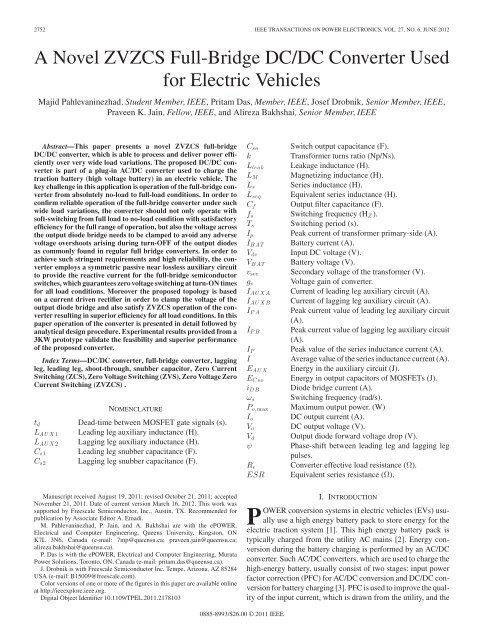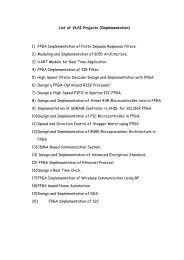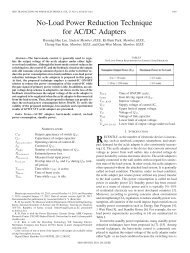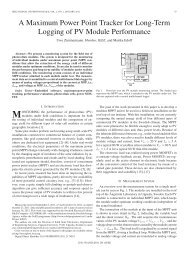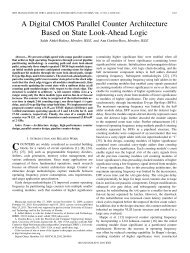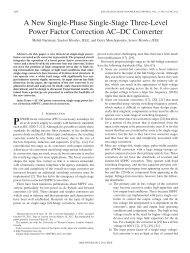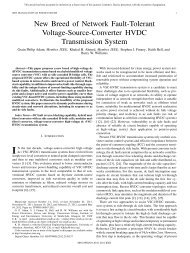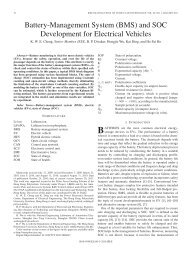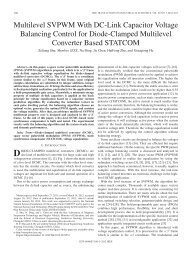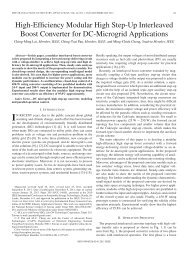A Novel ZVZCS Full-Bridge DC/DC Converter Used ... - IEEE Xplore
A Novel ZVZCS Full-Bridge DC/DC Converter Used ... - IEEE Xplore
A Novel ZVZCS Full-Bridge DC/DC Converter Used ... - IEEE Xplore
Create successful ePaper yourself
Turn your PDF publications into a flip-book with our unique Google optimized e-Paper software.
PAHLEVANINEZHAD et al.: NOVEL <strong>ZVZCS</strong> FULL-BRIDGE <strong>DC</strong>/<strong>DC</strong> CONVERTER USED FOR ELECTRIC VEHICLES 2753charger which is an isolated <strong>DC</strong>/<strong>DC</strong> converter, is used to chargethe high voltage battery and provide galvanic isolation betweenthe utility mains and the traction battery [31], [32], [35], [36].<strong>Full</strong>-bridge topology is the most popular topology used in thepower range of a few kilowatts (1–5 KW) for <strong>DC</strong>/<strong>DC</strong> converters.Since the switch ratings are optimized for the full-bridgetopology, this topology is extensively used in industrial applications.High efficiency, high power density, and high reliabilityare the prominent features of this topology [38]–[40].For applications in the range of a few kilowatts, MOSFETsare mostly used to implement the full-bridge converters. In orderto have robust and reliable operation, MOSFETs shouldbe switched under zero voltage. Operation with zero voltageswitching (ZVS) has numerous advantages including, for example,reduction of the converter switching losses and a noise-freeenvironment for the control circuit. Zero voltage switching isusually achieved by providing an inductive current flowing outof the full-bridge legs during the switch turn-ON and by placinga snubber capacitor across each switch during the switchturn-OFF. The inductive current can be produced by insertingan inductor in series with the power transformer or by insertingan inductor in parallel with the power transformer [4]–[11].In a practical full-bridge configuration, the internal drain-tosourcecapacitor of the MOSFET is usually utilized as thesnubber capacitor, the series inductor is usually the leakageinductance of the power transformer, and the parallel inductoris implemented by using the magnetizing inductance of thepower transformer. Thus, external passive components are notrequired, which makes the power circuit very simple and efficient.However, the full-bridge converter with the series inductorloses its ZVS capability at light loads, and the converter withthe parallel inductor loses its ZVS under heavy loads. Loss ofZVS implies extremely high switching losses at high switchingfrequencies and very high EMI due to the high di/dt of thesnubber discharge current. Loss of ZVS can also cause a verynoisy control circuit, which leads to shoot-through and loss ofthe semiconductor switches. The ZVS range can be extended byincreasing the series inductance. However, having a large seriesinductance limits the power transfer capability of the converterand reduces the effective duty ratio of the converter.In battery charger applications, ZVS is vitally important sincethe converter might be operating at absolutely no-load for along period of time. In this application, when the battery ischarged, the load is absolutely zero and the converter shouldbe able to safely operate under the zero load condition. SinceZVS in conventional full-bridge PWM converters is achieved byutilizing the energy stored in the leakage inductance to dischargethe output capacitance of the MOSFETs, the range of the ZVSoperation is highly dependent on the load and the transformerleakage inductance. Thus, this converter is not able to ensureZVS operation for a wide range of load variations [12].In [11], a novel approach has been adopted to extend the ZVSrange in the full-bridge converter. In this approach, an auxiliaryinductor is put at the leading leg by deriving an auxiliary windingon the main transformer and confirms ZVS for the leading leg.Although the proposed scheme can effectively extend ZVS ofthe leading leg MOSFETs, it is not able to guarantee ZVS forFig. 1.Conventional full-bridge converter.the lagging leg of the converter. Thus, when the battery is fullycharged, the lagging leg switches may not be switched underZVS. Moreover, the voltage at the secondary side still suffersfrom the spikes due to the leakage inductance and voltage-fedrectifier, commonly seen in full-bridge converters.A fundamental problem related to the conventional fullbridgephase-shift <strong>DC</strong>/<strong>DC</strong> converter is the voltage spikes acrossthe output diodes. Fig. 1 shows the schematic of the conventionalfull-bridge converter. Basically, the leakage inductanceof the transformer causes the voltage spikes across the outputdiodes. Theses spikes are intensified by increasing the switchingfrequency of the converter. Thus, the diodes should be designedoverrated to be able to withstand the voltage spikes, which leadsto higher losses due to the higher forward voltage drop of thediodes and poorer reverse recovery characteristics. In addition,the spikes significantly increase the EMI noise of the converter.This fact makes the topology not very practical for high frequency,high voltage applications. There are quite a few referencesthat proposed solutions for the voltage spikes across theoutput diodes. Some references tried to decrease the leakageinductance as much as possible though the transformer windingstructures, which effectively decreases the peak of the voltagespikes across the output diodes. However, reducing the leakageinductance decreases the ZVS operating range of the full-bridgeconverter, which results in a very narrow range of ZVS operation.In [13], an R-C-D snubber circuit is used to mitigate thevoltage spikes across the diodes. The main problem with thesnubber circuit is the amount of losses in the snubber resistor,which considerably degrades the efficiency of the converter especiallyat higher power and it can only reduce the peak valueof the voltage spikes. In [14], an active clamp circuit has beenadded to the converter to clamp the voltage across the outputdiodes. This method can effectively clamp the voltage spikes ofthe output diodes. However, the active clamp circuit increasesthe complexity of the converter and causes small losses in theclamp circuit. Several energy recovery clamp circuits (ERCCs)have been proposed in [15]–[20]. In [21], an improved ERCCmethod has been proposed to accommodate the effects of voltagespikes for a wide range of input voltage. Although the ERCCtechniques are able to reduce the voltage stress of the output
2754 <strong>IEEE</strong> TRANSACTIONS ON POWER ELECTRONICS, VOL. 27, NO. 6, JUNE 2012diodes, the amount of the voltage stress depends on the dutyratio and input voltage of the converter in most of the ERCCstechniques. In addition, using extra semiconductors is inevitablein all these aforementioned methods.The problem of voltage spikes is essentially related to thevoltage-driven output rectifiers. This is due to the fact thatthe full-bridge inverter produces high frequency voltage pulsesacross the output diode rectifier, which is connected to the outputinductor as shown in Fig. 1. The voltage-driven rectifierworks perfectly if there is no leakage inductance in between theoutput of the full-bridge inverter and the diode rectifier. However,the existence of the leakage inductance makes the rectifierconnect two current sources, i.e., leakage inductance and outputinductance, together. This connection creates high voltagespikes across the output diodes. In this paper, a new topology isproposed based on a current driven rectifier, which effectivelyrectifies the voltage stress problems related to the full-bridge<strong>DC</strong>/<strong>DC</strong> converter. The proposed topology provides zero currentswitching (ZCS) for the output rectifiers, which eliminatesreverse recovery losses of the output diode rectifiers.In [37], a new modified current-fed full-bridge is presentedin order to reduce the voltage stress arising in the conventionalcurrent-fed full-bridge converter. In the current-fed full-bridgein [37], the inductor stores energy as the transformer transmitsenergy from the <strong>DC</strong> source to the load. This scheme is able to effectivelyreduce the voltage spikes at the input-side (full-bridgeMOSFETs) of the converter. In addition, the input inductor isreplaced by coupled inductors in series with two MOSFETs toreduce the size of the inductor. The fundamental difference betweenthe proposed converter and the converter in [37] is that inthe proposed converter, the full-bridge section at the transformeris the conventional voltage-fed topology, while in [37] the inputsection of the converter is a modified current-fed topology.In the battery charger applications, the converter should beable to operate from absolutely no-load to full-load condition.In order to achieve zero voltage switching for the whole loadrange, the proposed converter uses a passive circuit to providethe required inductive current for the power MOSFETs. In [22],the detailed analysis of the auxiliary circuit is given.This paper is organized as follows: In Section II, the proposedtopology is introduced and different operating modes aredescribed. The steady-state operation of the converter is analyzedin Section III. In Section IV, features of the proposedtopology are presented. Design procedure for key componentsof the converter is given in Section V. Section VI shows theexperimental results obtained from the converter prototype andfinally, Section VII, provides the conclusion.II. PROPOSED TOPOLOGYThe main problem regarding the conventional full-bridge converteris the series connection of the leakage inductor and outputinductor through the diode rectifier. In other words, the dioderectifier at the secondary side of the converter connects two currentsources together. This leads to large voltage spikes acrossthe diode rectifier and very lossy commutation of the current inthe rectifier diodes. This phenomenon is intensified in high volt-Fig. 2.Proposed converter.age applications due to the inevitable large leakage inductance.This fact forces designers to over design the diode rectifier atthe output side. For instance, designers usually use even 1200 Vdiodes for a 400 V output <strong>DC</strong> power supply. This phenomenonis usually mitigated by using snubber circuits or clamp circuits.However, the snubber circuits are usually lossy especially forhigh frequency applications. In addition, the voltage spikes arehighly intensified by increasing the load, which makes the snubbercircuit a very poor solution for high frequency applications.Basically, this problem exists with all topologies that use transformerswith voltage-driven rectifiers. Generally, in converterswith voltage-driven rectifiers, there is an inductor at the outputof the rectifier and the leakage inductance of the transformerinterferes with this inductor.Moreover, in full-bridge <strong>DC</strong>/<strong>DC</strong> converters with high outputvoltages (such as 400 V or higher), the equivalent capacitanceviewed from the transformer primary side is not negligible.This is due to the high number of turns at the secondary andto the required high voltage semiconductors with high value ofoutput capacitance. In high frequency applications, these parasiticcapacitances resonate with the leakage inductance of thetransformer, which leads to a very high resonant current in theprimary of the transformer. Therefore, this capacitor completelydeteriorates the performance of the converter in high switchingfrequency applications. The conventional full-bridge topologyexhibits very poor performance due to the secondary side componentsin high frequency high voltage applications.The topology introduced in this paper presents a novel yetsimple solution to this problem. The proposed topology is essentiallya <strong>ZVZCS</strong> type full-bridge converter with a currentdrivenrectifier. Fig. 2 shows the power circuit of the proposedtopology. In this topology, the full-bridge inverter converts the<strong>DC</strong>-bus voltage to a high frequency quasi-square wave voltage.Then there is an inductor in series with the transformer, whichacts as a current source for a current driven rectifier. The currentdriven rectifier rectifies the output current of the transformer andtransfers power to the output. Fig. 3 illustrates the key waveformsof the converter. In one switching cycle, the circuit has14 modes during steady-state operation. Due to the symmetricalstructure, the analysis is only given for half a switching cycle.In half cycle, the steady state behavior of the circuit is dividedinto the following operating modes:Mode I: (t 0 ≤ t ≤ t 1 ): At t 0 , S 2 is turned OFF. The outputcapacitor of S 1 is discharging and that of S 2 is chargingup with the reactive current provided by the auxiliary circuit.
PAHLEVANINEZHAD et al.: NOVEL <strong>ZVZCS</strong> FULL-BRIDGE <strong>DC</strong>/<strong>DC</strong> CONVERTER USED FOR ELECTRIC VEHICLES 2755Fig. 3.Ideal waveforms of the converter.During this interval, the secondary-side diodes are reversed biasedand are OFF. Therefore, the rising voltage v AB conductsa very small current through the <strong>DC</strong> blocking capacitor C b ,seriesinductance L s , leakage inductance L leak , and magnetizinginductance L M . Fig. 4(a) shows the active components in thismode of operation. The current through the series inductanceL s , is given by∫1ti s (t) =v AB dt. (1)L s + L leak + L M t 0Due to the fact that L M is large, the amount of current flowingthrough the primary side of the transformer is much smaller than
2756 <strong>IEEE</strong> TRANSACTIONS ON POWER ELECTRONICS, VOL. 27, NO. 6, JUNE 2012Fig. 4 (a) Active components of Mode I. (b) Active components of Mode II. (c) Active components of Mode III. (d). Active components of Mode IV. (e) Activecomponents of Mode V. (f) Active components of Mode VI. (g) Active components of Mode VII.the current through the auxiliary circuit i AUXA . According tothis assumption v AB is calculated asv AB (t) =V dc − v Cso (t) (2)v Cso (t) =V dc − I PA(t − t 0 ). (3)2C soBy using (1)–(3), the equation of the series current is calculatedasi s (t) =I PA4(L s + L M + L leak ).C so(t − t 0 ) 2 . (4)This interval ends once the voltage across the secondaryreaches the output voltage plus the voltage drops of the diodesto forward bias the output diodes. Thus, t 1 is given byt 1 = t 0 + 2k(V o +2V d ).(L s + L M + L leak ).C soL M .I PA. (5)Mode II (t 1 ≤ t ≤ t 2 ): This mode starts once the outputdiodes get forward biased. Fig. 4(b) shows the active componentsin this mode. According to this figure, the output capacitorof the MOSFET, S 1 is still discharging to finally reach zero andthat of S 2 is charging up to V dc . This mode ends once the voltageacross this capacitor becomes zero. In this interval, the series
PAHLEVANINEZHAD et al.: NOVEL <strong>ZVZCS</strong> FULL-BRIDGE <strong>DC</strong>/<strong>DC</strong> CONVERTER USED FOR ELECTRIC VEHICLES 2757current i s , is calculated as∫1 ti s (t) =(v AB − k(V o +2V d )) dt (6)L s + L leak t 0v AB is given byv AB (t) = I PA(t − t 1 ). (7)2C soPlacing (7) into (6), i s is given byI PAi s (t) =(t − t 1 ) 2 − k(V o +2V d )(t − t 1 ).4(L s + L leak ).C so L s + L leak(8)This interval ends once the output capacitor of the MOSFETS 1 , has discharged completely. Therefore, t 2 is calculated using(3) as follows:t 2 = t 0 + 2V dc.C so. (9)I PAMode III (t 2 ≤ t ≤ t 3 ): This mode starts once the MOSFEToutput capacitors have been charged and discharged completely.Fig. 4(c) shows the active components in this mode. During thismode, the output diodes clamp the secondary voltage to theoutput voltage. Thus, there is a constant voltage across the combinationof the series inductance and the leakage inductance.Therefore, the series current ramps up to its peak value. Accordingto Fig. 4(b), the series current i s , is given byi s (t) = V dc − k(V o +2V d )(t − t 2 ). (10)L s + L leakThe peak value I p of the series current i s is determined byusing (4), (5), (8)–(10), and the amount of phase-shift betweenthe leading leg and the lagging leg of the full-bridge inverterI p = 2k2 .(V o +2V d ) 2 .(L s + L leak + L M ).C soL 2 M .I PAI PA+(L s + L leak ).C so(Vdc .C so× − k(V ) 2o +2V d ).(L s + L leak + L M ).C soL M .I PAI PA− 2k(V o +2V d )L s + L leak(Vdc .C so× − k(V )o +2V d ).(L s + L leak + L M ).C soL M .I PAI PA+ V ( )dc − k(V o +2V d ) ψ− t d . (11)L s + L leak ω sThis mode ends once the MOSFET S 4 , gate voltage becomeszero. The end of this interval t 3 , is given byt 3 = t 2 + ψ ω s− t d . (12)Mode IV (t 3 ≤ t ≤ t 4 ): Fig. 4(d) illustrates the active circuitduring this mode. During this interval the output capacitor of S 3is discharging from and that of S 4 is charging up to V dc .Inthisinterval, the output voltage of the inverter v AB, is given by()tv AB (t) =V dc − V dc Sin √2Cso .(L s + L leak ) − t 3− I PB2C so(t − t 3 ). (13)The series current is calculated using (13) as follows:[1Vi s (t) =V dc (t − t 3 )+ √ dcL s + L leak 2Cso .(L s + L leak )()Cost√2Cso .(L s + L leak ) − t 3− I PB4C so(t − t 3 ) 2 ]− k(V o +2V d )(t − t 3 )+I p . (14)L s + L leakThis mode ends once the S 3 output capacitor got completelydischarged and S 4 output capacitor got charged to V dc . The endof this mode t 4 is determined by solving (13) for v AB (t 4 )=0.Mode V (t 4 ≤ t ≤ t 5 ): Fig. 4(e) shows the active componentsduring this mode of operation. Once this voltage v AB , becomeszero this mode commences. During this mode, the output voltageof the inverter is zero and the output diodes clamp the secondaryvoltage to the output voltage. Thus, a net negative voltage isincident across the series inductor, which is the reflected outputvoltage at the transformer primary side. This causes the currenti s to ramp down. According to Fig. 4(e), the series current isgiven byi s (t) =i s (t 4 ) − k(V o +2V d )(t − t 4 ). (15)L s + L leakThis interval is part of the dead time between the gatingpulses of S 3 and S 4 . Therefore, in this mode the body diode ofS 3 is conducting. Once the gate pulse of S 3 is applied this modefinishes and the current flows through the MOSFET channel.Mode VI (t 5 ≤ t ≤ t 6 ): This mode starts when the gate pulseis applied to S 3 . The active components in this mode are shownin Fig. 4(f). The equivalent circuit is the same as the previousmode except S 3 channel is conducting in this mode rather thanthe body diode of S 3 . Therefore, the series inductor current is stillramping down to reach zero at the end of this mode. It should benoted that S 1 turns off under near zero current switching at theend of this mode. At the end of this mode, the current throughthe series inductor reaches zero, so that the output diodes D 2and D 3 naturally turn off with zero current.Mode VII (t 6 ≤ t ≤ t 7 ): Fig. 4(g) shows the active componentsduring this mode of operation. This interval starts oncethe current through output diodes reaches zero and the diodesnaturally turn off with zero current. During this mode, the outputcapacitor C f feeds the output load with its stored energy whileon the transformer primary side there is no current.The modes of operation of the converter are slightly differentfor light loads. In particular, Mode IV is subdivided intotwo modes for light load conditions due to the small value ofpeak current I p , in the series inductor. There are basically twosources of current to charge and discharge the MOSFET output
2758 <strong>IEEE</strong> TRANSACTIONS ON POWER ELECTRONICS, VOL. 27, NO. 6, JUNE 2012Fig. 6.cycle.Series inductor current and voltage waveforms for half a switchingFig. 5.Submodes of Mode IV.capacitors. The first is the auxiliary circuit current and the secondis the current flowing in the series inductance. In light loads,the latter is not enough to charge and discharge the MOSFEToutput capacitors. Therefore, the lagging edge of the inverteroutput voltage has two different slopes at light loads. The firstslope is determined by the auxiliary circuit current and I p whilethe second slope is determined by the auxiliary circuit current.That is why there are two different modes of operation duringMode IV. Fig. 5 shows the submodes of Mode IV at light loads.III. ANALYSIS OF STEADY-STATE OPERATIONIn this section, the steady-state operation of the converteris analyzed. The following assumptions are considered for thederivations:1) The converter losses are neglected, which implies that theinput power of the converter equals to the output power.2) The energy transferred from primary to the secondaryside of the transformer during Mode I and Mode II of theoperation, which extends from time t 0 to t 2 , is neglectedsince the series inductance current is negligible duringthese intervals.3) The change in the waveform of the series inductor currentduring Mode IV of operation is neglected since the durationof Mode IV is very small compared to the switchingcycle.4) All passive components are considered to be ideal, whichimplies the ESRs of inductors and capacitors are neglected.5) The magnetizing inductance of the transformer is largeenough to have a negligible magnetizing current.6) The voltage ripple across the output filter capacitor is verysmall considering the application of battery charging.Fig. 6 illustrates the series inductance current and voltagewaveforms. In order to calculate the conversion ratio of the converter,the average value of the series inductance current shouldbe determined. According to Fig. 6 and the aforementioned assumptions,the average value of the series inductance current isgiven byI = 2 ( ) 2 ( ) ( )ψ Vdc Vdc − kV o− t d . .. (16)T s ω s kV o L s + L leakIn order to find the conversion gain, the power balance equationis used. The power balance is given byk.I.V o = V BAT .I BAT . (17)By using (16) and (17) the gain of the converter is given byg v = V oV dc=2√ (k + k 2 +) (18)4(L s +L leak )T s .R e .( ψω −t sd ) 2where R e is the effective load of the converter and is given byR e = V BATI BAT. (19)Fig. 7 shows the converter gain with respect to the phase-shiftangle of the full-bridge inverter for different load conditions.According to this figure, the variations of the gain are morepronounced for light loads in smaller values of phase-shift angle,while the gain varies more consistently for heavier loads. This isdue to the fact that the current in the series inductance has a verysmall peak for light loads; hence, the duration of Mode IV–VIis very short, whereas this duration is significant compared tothe switching cycle at heavy loads.
PAHLEVANINEZHAD et al.: NOVEL <strong>ZVZCS</strong> FULL-BRIDGE <strong>DC</strong>/<strong>DC</strong> CONVERTER USED FOR ELECTRIC VEHICLES 2759discharge the leading leg MOSFET output capacitors. This canbe concluded from Mode I of the converter operation. Therefore,both the auxiliary inductors only carry small amounts ofcurrent, just enough for the ZVS turn–ON of the MOSFETs.Therefore, the two auxiliary circuits are symmetric and, hence,easier to manufacture.Fig. 7.<strong>Converter</strong> gain for different load conditions.IV. FEATURES OF THE PROPOSED TOPOLOGYIn this section, the salient features of the proposed converterare discussed as follows:A. Zero Voltage Switching (ZVS) of the <strong>Full</strong>-<strong>Bridge</strong> SwitchesFrom Absolutely No-Load to <strong>Full</strong>-Load ConditionIn electric vehicle applications, the power converter should beable to operate at absolutely no-load condition for long periodsof time. The conventional full-bridge converters lose ZVS atlight loads. This limits the use of the conventional full-bridgeconverter in such applications. Two auxiliary circuits are placedto provide reactive current for ZVS turn–ON of the full-bridgeswitches independent of the load condition [22], [23]. Although,the auxiliary circuit increases the current of the MOSFETs, thiscurrent is essential to ensure reliable operation of the converter inthe battery charging application, where the converter operatesat no-load for a long period of time. Losing ZVS at no-loadimplies a significant amount of switching losses especially athigh switching frequencies and very noisy control and gate drivecircuit, which may cause shoot-through and failure of the powerMOSFETs.B. Same Amount of Reactive Current Requirement for LeadingLeg and Lagging Leg ZVS TransitionIn [22], it is proven that the amount of reactive current requiredto guarantee ZVS for the leading leg is higher than theone for lagging leg due to the extra negative current in the transformerleakage inductor, which has to be compensated by theauxiliary circuit. This implies that the leading leg auxiliary inductorshould carry much more current than the lagging leg. Theextra current in the auxiliary inductor significantly increases theconduction losses in the leading leg switches as well as in theleading leg auxiliary inductor. In the proposed topology, due tothe fact that the series inductor current starts from zero duringthe switching of the leading leg MOSFETs, the auxiliary circuitmust only provide just enough reactive current to charge andC. Near Zero Current Switching (ZCS) of the LeadingLeg MOSFETsIt is evident from Mode I and Mode VII that when the leadingleg switches are turned on, the current in the series inductor iszero. The only current in the leading leg switches is the auxiliarycircuit current during these modes. Considering the fact that thecurrent in the auxiliary circuit is much smaller than the currentin the series inductor it can be concluded that the MOSFETs ofthe leading leg undergo near ZCS turn-ON.D. Elimination of Voltage Spikes Across the Output Diode andInherent Voltage Clamping Across the Output DiodeIn the proposed topology, the voltage spikes across the outputdiodes are eliminated by using a current-driven configuration,which is realized by a series inductance with the main powertransformer operating in discontinuous mode ensuring completeenergy transfer and a capacitive filter at the output of the diodebridge. The series inductor acts as a current source and thecapacitive filter clamps the voltage across the diode bridge.E. Natural Lossless Commutation of Output DiodesDue to the current-driven nature of the output rectifier, theoutput diodes turn off naturally when the current in the seriesinductance reaches zero. This eliminates any reverse recoveryand switching losses in the output diode bridge and guarantees asafe and reliable operation of the secondary side of the converter.Fig. 3 illustrates the lossless commutations of the output diodes.F. Elimination of the Freewheeling Mode in <strong>Full</strong>-<strong>Bridge</strong> Inverterand the Output Diode <strong>Bridge</strong>In conventional full-bridge converters, when the output voltageof the inverter rises to V dc , the current though the leakageinductance increases to reach the reflected output inductor current.Once it reaches the reflected output inductor current, thevoltage at the transformer secondary side rises to V dc /k.Duringthis time the output diodes are freewheeling and the transformersecondary voltage is near zero. In this period, the output inductorcurrent is flowing through the output diodes and the leakageinductance current is circulating in the primary side of the converter.The freewheeling operating mode significantly increasesthe losses of the converter especially for heavy loads. In theproposed topology, the freewheeling mode is completely eliminateddue to the current-driven structure at the primary side andcapacitive output filter at the secondary side.G. Discontinuous Mode of Conduction of the Series InductorThe operation in <strong>DC</strong>M of the series inductor plays an importantrole in eliminating the voltage spikes across the diode
2760 <strong>IEEE</strong> TRANSACTIONS ON POWER ELECTRONICS, VOL. 27, NO. 6, JUNE 2012rectifier. This allows use of 600 V diodes to implement the outputdiode bridge. Elimination of the voltage spikes guaranteeshighly reliable operation of the converter for heavy loads. However,the <strong>DC</strong>M operation increases the rms and peak values ofthe series inductor current, which may deteriorate the efficiencyat very heavy loads.H. Improved EMIAnother main advantage of the proposed method comparedto the conventional phase-shift full-bridge controller is very lowamount of EMI produced by the proposed converter. In conventionalphase-shift full-bridge converter, the voltage spikesof the output diodes and the reverse recovery phenomenon duringdiode transitions are significant sources of EMI, which deterioratethe performance of the converter in high frequencyrange. Due to the fact that the converter for traction battery isconnected to the utility mains to charge the traction battery, thesehigh frequency voltage spikes are injected to the grid from theconverter. Therefore, the converter requires a bulky EMI filterat the input side to suppress the effects of the high frequencyvoltage ringing present at the output side of the converter. Theproposed converter operates without any high frequency spikesat the output diodes as well as the full-bridge <strong>DC</strong>-bus due tothe current driven structure and auxiliary circuits in the primaryside.V. DESIGN PROCEDUREIn this section, the design procedure of the proposed converteris presented. The main components, which require special considerationswhile designing, are the auxiliary inductors, seriesinductor, and output capacitor.A. Design of Auxiliary InductorsAuxiliary inductors are designed based on the amount of reactivepower required to guarantee ZVS for the MOSFETs. Inother words, the reactive current should be enough to completelycharge and discharge the MOSFET output capacitors.In [22], the design procedure of auxiliary circuits for a regularfull-bridge converter is explained. However, since there aresubstantial differences in operating modes for the leading leg,the design procedure is given accordingly. According to the operatingmodes of the proposed converter, described earlier, theworst case for ZVS operation is no-load. Thus, ZVS should beguaranteed for no-load in order to make sure ZVS operation forall operating conditions. At absolutely no-load, the primary currentis zero during the switching transitions of the leading leg.Therefore, the current through auxiliary circuit of the leadingleg should only charge and discharge the output capacitors ofthe MOSFETs. Fig. 8 illustrates the auxiliary circuit waveforms.Considering the operating modes of the proposed converter andthe discussion given in the previous section, the auxiliary circuitsfor this topology are completely symmetric unlike the auxiliarycircuits for the regular full-bridge in which the amount of the reactivecurrent should be more for the leading leg. Due to the factthat the auxiliary circuit current remains pretty constant duringFig. 8.Auxiliary circuit waveforms.the dead-time, the auxiliary inductor acts as a constant currentsource, which discharges the capacitor across S 1 and chargesthe capacitor across S 2 . According to Fig. 8, the value of thisconstant current source is derived asI PA =V dc8L AUX1 .f s. (20)In order to design the inductor for the auxiliary circuits, firstthe amount of energy required to charge and discharge the outputcapacitors of the MOSFETs are calculated. Then the amountof dead-time required to allow complete charging and dischargingis derived. Therefore, the amount of energy stored in theauxiliary inductor is given byE AUX = 1 2 .L AUX1.I 2 PA. (21)The amount of energy required to charge and discharge theoutput capacitors of the MOSFETs is given byE Cso = C So .Vdc. 2(22)Therefore, the value of the auxiliary inductance is designedas1L AUX1 =128C So .fs2 . (23)In order to ensure ZVS, the dead-time t d , should be adjustedto allow the output capacitors of the MOSFETs to fully chargeand discharge and is given byt d = 2C So.V dc. (24)I PAIt should be noted that the auxiliary inductors are AC inductors.Therefore, the maximum flux density considered for theseinductors should be limited to avoid significant core losses.In [22], the design of the auxiliary inductors is explained indetail.B. Design of Series InductorThe series inductor should be designed so that the converterfull-load condition corresponds to the critical conduction modeof the series inductor. Fig. 9 shows the critical conduction modeof the series inductance, which is used to design the series
PAHLEVANINEZHAD et al.: NOVEL <strong>ZVZCS</strong> FULL-BRIDGE <strong>DC</strong>/<strong>DC</strong> CONVERTER USED FOR ELECTRIC VEHICLES 2761Fig. 9.Critical conduction mode.Fig. 10.Transformer winding configuration.inductor. According to this figure, the reflected output current atthe primary side is half of the peak current in the series inductor.Therefore, the value of series inductance is given byL seq = V dc − kV o2I o.( ψω s− t d). T s2(25)whereL seq = L s + L leak .Replacing the phase-shift from the expression for the gain ofthe converter given by (18), the series inductance is given by(L seq = 1+k V )o V2o T sV dc P o,max 64 . (26)This series inductance L seq plays a major role in the energytransfer from the primary to the secondary side of the transformer.This inductance by nature is an AC inductor. So regulardesign methods [22], [30] of an AC inductor with air-gap hasto be followed if an external inductor is to be designed for theseries inductor, L s . This inductance can be integrated as theleakage inductor of the transformer too. Although in that case,a transformer with a precisely designed leakage inductance willbe necessary but the advantage of having this integrated seriesinductance is immense including elimination of an actualphysical inductor along with its core and copper losses and theadverse effects of its fringing flux on the EMI and the operationof the surrounding devices on the PCB of the converter.In order to enjoy the advantages of having an integrated seriesinductor, design of the transformer leakage is closely studied inthis section [24]. In order to calculate the magnetic field in atransformer the following assumptions are made:1) The winding consists of a large number of turns whichare placed close to each other and the cross-sectional areaof the wire used for winding is small compared to thewinding cross section.2) The magnetic field intensity inside the ferrite core is uniformand constant.Although there can be numerous configurations of windingson a bobbin, in this section only the two-winding top-bottomarrangement is considered. This winding structure is shown inFig. 10. It is evident in this figure that this winding providesexcellent isolation between two windings, which is essential forthis application. The magnetic flux distribution pattern can bederived by Amper’s Law.The leakage inductances l 1 and l 2 of each winding arisesdue to the magnetic flux which is stored only in the windingand not in the core and the effective leakage inductance of onewinding is evaluated by electrically shorting the other winding.For calculating leakage inductance at the primary winding, thesecondary winding is shorted. Under such a shorted condition,the field intensity along the cross section of the winding isshown in Fig. 10, with the mutual flux approximately reducedto zero. The leakage inductance l 1 is calculated by evaluatingthe following volume integral over the window area of the coreoccupied by the primary winding∫∫∫l 1 = μ oI12 H(ρ 2 )dv. (27)Similarly, the reflected leakage inductance of the secondarywinding on the primary side is given by∫∫∫l 2 = μ oI12 H(ρ 2 )dv (28)evaluated over the volume occupied by the secondary windingon the bobbin.Evaluation of the above integrals givesl 1 = μ (o ch N 12 2 + b )1(29)3l 2 = μ oh N 2 1( c2 + b 23). (30)The equivalent leakage inductance on the primary side isgiven byl eq = l 1 + l 2 = μ (oh N 12 c + b )1 + b 2. (31)3From the expression for equivalent leakage inductance it canbe realized that for a given winding span and winding volume onthe bobbin, the leakage inductance can be fine tuned by variationof the distance c between the two windings. This feature isunique to this type of layout of the windings and cannot beexploited in the common method of laying the windings one ontop of each other and just have the insulating material separatingthem. Moreover, this gap between the windings also ensuresproper clearance and henceforth isolation between the windings,which is extremely essential for automotive applications thatrequire strict isolation levels between the high voltage traction
2762 <strong>IEEE</strong> TRANSACTIONS ON POWER ELECTRONICS, VOL. 27, NO. 6, JUNE 2012TABLE ICONVERTER SPECIFICATIONSTABLE IIPROPOSED FULL-BRIDGE PASSIVE COMPONENTSFig. 11 (a) Output capacitor waveforms for a typical load. (b) Output capacitorwaveforms for full-load.battery ground and the input utility mains following the electriccar isolation standards [33].C. Design of Output CapacitorFig. 11(a) shows the voltage and current of the output capacitorfor a typical load. This capacitor is designed for themaximum load of the converter. Therefore, the minimum valueof the capacitor is designed to assure operation in the criticalconduction mode at peak load. The voltage and current waveformsof the capacitor are shown in Fig. 11(b) for the criticalconduction mode. According to this figure the value of the capacitoris designed byI oC f =(32)8f s .ΔV Cfwhere ΔV Cf is usually considered as 5%–10% of the outputvoltage. In the implemented prototype of this converter thiscapacitor value is chosen to be higher than the one given by(32).VI. EXPERIMENTAL RESULTSA 3-KW prototype is implemented to verify the performanceof the proposed converter. The designed specifications are shownin Table I. Table II shows the passive components used to implementthe proposed full-bridge converter. Fig. 12 illustratesthe block diagram of the converter. At the input stage, thereis an inrush current protection, which limits the inrush currentof the converter. Since there is usually a big capacitor at theoutput of the PFC, the inrush current to charge the capacitoris very high and a circuit is required to limit this current. Thenext block is the EMI filter which is designed to comply withthe EMI standard (CISPR25/12) for electric vehicles [25], [26].The following block is the input diode rectifier. It rectifies theinput voltage for the two-phase interleaved boost converter. Theinterleaved boost converts the rectified input voltage to the intermediate<strong>DC</strong>-bus voltage. The output capacitor of the interleavedboost converter is large (1.4 mF) in order to decrease the secondharmonic voltage ripple caused by the power ripple of the inputboost PFC converter. In addition, there is a differential-mode(DM) filter at the output of the PFC in order to filter out thedifferential-mode noise. At the output of this filter, a clean <strong>DC</strong>busvoltage is provided to the full-bridge converter. Note thatanother EMI filter is required at the output of the full-bridgeconverter in order to provide filtering for the EMI noise injectedby the inverter. Since the inverter is connected to the high energybattery, it injects switching noise to the battery charger.In order to achieve a high power density, the semiconductorsare used in the form of power modules. There are two powermodules used in the AC/<strong>DC</strong> converter. The first module shownin Fig. 13(a) consists of the input full-bridge rectifier, the interleavedboost MOSFETs including the driver circuit for theMOSFETs and the output boost diodes designed to be usedfor the PFC. Another module shown in Fig. 13(b) consistingof the full-bridge MOSFETs along with their driver circuitsas well as the output diode rectifier is used to implement the
PAHLEVANINEZHAD et al.: NOVEL <strong>ZVZCS</strong> FULL-BRIDGE <strong>DC</strong>/<strong>DC</strong> CONVERTER USED FOR ELECTRIC VEHICLES 2763Fig. 12.<strong>Converter</strong> block diagram.TABLE IIIPFC POWER MODULE COMPONENTSTABLE IVFULL-BRIDGE POWER MODULE COMPONENTSFig. 13module.(a) Interleaved boost power module. (b) <strong>DC</strong>/<strong>DC</strong> converter powerfull bridge converter and its secondary side bridge rectifier. Thecomponents, which are used in PFC power module and in fullbridgepower module, are shown in Tables III and IV, respectively.Since the semiconductors used in the power modulesare in die package, the parasitic components are minimized in-side the module. This leads to superior performance under highswitching frequency where resonance in the parasitic componentstends to deteriorate the performance of the system. Thediode CPW2-0600S010, which is used at the output of the interleavedboost rectifier, is a silicon-carbide diode and it has a zeroreverse recovery [34]. The phase-shift full bridge convertersusually suffer from the slow body diodes of the MOSFETs. Theslow body diode causes voltage spikes due to the reactive currentflowing through MOSFETs during the switching times. Dueto the inductive path, using a fast diode parallel to the discreteMOSFET does not solve the problem. However, this problemcan be solved using dies instead of discrete components; so thereare four silicon carbide diodes added in parallel to the powerMOSFETs in the full-bridge power module. UCC27322D isselected to drive the MOSFETs. This driver is able to drive9 A peak current, which speeds up the switching transitions
2764 <strong>IEEE</strong> TRANSACTIONS ON POWER ELECTRONICS, VOL. 27, NO. 6, JUNE 2012Fig. 15.Proposed converter waveforms at no load.Fig. 14 (a) Waveforms of the conventional full-bridge converter with auxiliarycircuit at 10% load. (b) Waveforms of the conventional full-bridge converter withauxiliary circuit at full-load.significantly. Fig. 13(c) shows the industrial prototype of theconverter inside the water-cooled enclosure.In order to implement the proposed controller, theTMX320F28335 eZdSP board is employed. This DSP boardis a floating-point DSP, which offers a very flexible environmentfor advanced calculations. This DSP has a 12-bit A<strong>DC</strong>with a sequencer that is able to convert multiple analog signalssequentially [27]. It also has six EPWM (Enhanced PWM)modules, which can produce the desired PWM signals with avery high degree of flexibility [28]. The EPWM channels canbe practically used up to 100 KHz. However, for the higherfrequency range, the high resolution EPWM should be used toachieve a high resolution PWM signal and to avoid the limitcycle and instability. The high resolution module is embeddedin the DSP [29]. Since the switching frequency is high, thehigh resolution module should be utilized to produce the PWMpulses.Fig. 16.Proposed converter waveforms at 10% load.In order to compare the performance of the proposed converterwith the full-bridge converter, a prototype of the fullbridgeconverter with the same specification in Table I is implemented.Asymmetric auxiliary circuit [22] was added to theconventional full-bridge to be able to operate at light loads.Table V shows the key components of the conventional fullbridgeconverter.Fig. 14(a) shows different waveforms of the conventionalfull-bridge converter operating at 10% load. According to thisfigure, the secondary voltage of the transformer which is incidentacross the output diode-bridge shows significant voltage spikes.Fig. 14(b) illustrates the waveforms of the conventional fullbridgeconverter operating at full-load. This figure shows severevoltage spikes across the transformer secondary voltage.
PAHLEVANINEZHAD et al.: NOVEL <strong>ZVZCS</strong> FULL-BRIDGE <strong>DC</strong>/<strong>DC</strong> CONVERTER USED FOR ELECTRIC VEHICLES 2765TABLE VCONVENTIONAL FULL-BRIDGE PASSIVE COMPONENTSFig. 18 (a) Proposed converter waveforms at 50% load. (b) Proposed converterenlarged waveforms at 50% load.Fig. 17 (a) Proposed converter waveforms at 25% load. (b) Proposed converterenlarged waveforms at 25% load.The experimental results for the proposed topology are obtainedfor input voltage of 400 V<strong>DC</strong>, output voltage of 300 V<strong>DC</strong>,and output power of 0 to 3 KW. The switching frequency is220 KHz.Figs. 15–21 show the waveforms of the proposed converter fordifferent load conditions. Fig. 15 shows the waveforms for noloadcondition. According to this figure, the converter is able tooperate at absolutely no-load without any adverse voltage spikesacross any of the semiconductors. Fig. 16 shows the waveformsfor 10% load. Comparing Figs. 14(a) and 16, it is concludedthat the proposed converter has superior performance over theconventional converter especially in regards to the voltage acrossthe secondary-side diode-bridge. Fig. 17(a) and (b) shows theconverter waveforms at 25% load. It can be seen in Fig. 17(b),even at such light loads the full-bridge output voltage has verysmooth transitions at the leading and lagging edges; moreover,the series inductor current remains zero during the transition ofthe leading edge MOSFETs, which confirms that these switchesenjoy zero voltage and zero current switching. Also from the
2766 <strong>IEEE</strong> TRANSACTIONS ON POWER ELECTRONICS, VOL. 27, NO. 6, JUNE 2012Fig. 20 (a) Proposed converter waveforms at 85% load. (b) Proposed converterenlarged waveforms at 85% load.Fig. 19 (a) Proposed converter waveforms at 70% load. (b) Proposed converterenlarged waveforms at 70% load.output diode-bridge voltage waveform depicted in Fig. 17(b) thevoltage clamping effect of the filter capacitor, C f is appreciated.Fig. 18(a) and (b) illustrates the waveforms at 50% load.Fig. 19(a) and (b) shows the waveforms for 70% load. Fig. 20(a)and (b) depicts the waveforms for 85% load. From these figures,it is concluded that with increasing load Mode IV–VI gainprominence. Fig. 21 show the waveforms at full-load operationof the converter. The waveforms confirm operation of the converterclose to critical conduction mode for the series inductor.It should be appreciated from the waveforms presented in thissection that for the whole range of operation, the freewheelingmode of the output diode-bridge is eliminated due to the currentdriven nature of the output rectifier, which is a unique featureof the proposed topology. Fig. 22(a) and (b) show the auxiliarycircuit current along with the other waveforms of the converterfor two different loads.Fig. 21.Proposed converter waveforms at full-load.Considering the experimental results of the proposed topologyfor the output diode bridge, 600 V diodes can be used toimplement the output diode bridge rather than 1200 V diodeswith higher forward voltage drop and bigger packages as requiredby the conventional full-bridge converter.
PAHLEVANINEZHAD et al.: NOVEL <strong>ZVZCS</strong> FULL-BRIDGE <strong>DC</strong>/<strong>DC</strong> CONVERTER USED FOR ELECTRIC VEHICLES 2767Fig. 23.converter.Efficiency curves of the proposed and conventional full-bridgeoperation of the converter but also confirm the superiority of theproposed topology over the conventional full-bridge converter.REFERENCESFig. 22.Current in auxiliary circuit at different loads.Fig. 23 shows the efficiency curves of the proposed and conventionalfull-bridge converter. This figure confirms the superiorperformance of the proposed converter over the conventionalfull-bridge converter with the asymmetric auxiliary circuit. Accordingto this figure the efficiency is higher especially for heavyloads due to the elimination of the freewheeling mode, associatedreverse recovery losses of output diodes, <strong>ZVZCS</strong> switchingof the leading leg and ZVS switching of the lagging leg in theproposed topology.VII. CONCLUSIONIn this paper, a novel yet simple full-bridge topology is introducedfor high voltage battery charging applications in electricvehicles. The proposed converter eliminates the adverse effectsof the voltage spikes at the secondary side of the transformer, aswell as the freewheeling mode of operation, which are intrinsicto the conventional full-bridge converters. Moreover, the proposedconverter assures reliable operation at no load by applyingthe symmetric auxiliary circuits on both legs of the full-bridgeconverter. Experimental results and better efficiency of the proposedconverter over full range of operation not only validate the[1] S. M. Lukic, J. Cao, R. C. Bansal, F. Rodriguez, and A. Emadi, “Energystorage systems for automotive applications,” <strong>IEEE</strong> Trans. Ind. Electron.,vol. 55, no. 6, pp. 2258–2267, Jun. 2008.[2] L. Young-Joo, A. Khaligh, and A. Emadi, “Advanced integrated bidirectionalAC/<strong>DC</strong> and <strong>DC</strong>/<strong>DC</strong> converter for plug-in hybrid electric vehicles,”<strong>IEEE</strong> Trans. Veh. Technol., vol. 58, no. 8, pp. 3970–3980, Oct.2009.[3] A. Emadi, Y. J. Lee, and K. Rajashekara, “Power electronics and motordrives in electric, hybrid electric, and plug-in hybrid electric vehicles,”<strong>IEEE</strong> Trans. Ind. Electron., vol. 55, no. 6, pp. 2237–2245, Jun. 2008.[4] G.-B. Koo, G.-W. Moon, and M.-J. Youn, “Analysis and design of phaseshift full bridge converter with series-connected two transformers,” <strong>IEEE</strong>Trans. Power Electron., vol. 19, no. 2, pp. 411–419, Mar. 2004.[5] J. Wang, F. Z. Peng, J. Anderson, A. Joseph, and R. Buffenbarger, “Lowcost fuel cell converter system for residential power generation,” <strong>IEEE</strong>Trans. Power Electron., vol. 19, no. 5, pp. 1315–1322, Sep. 2004.[6] M. J. Schutten and D. A. Torrey, “Improved small-signal analysis forthe phase-shifted PWM power converter,” <strong>IEEE</strong> Trans. Power Electron.,vol. 18, no. 2, pp. 659–669, Mar. 2003.[7] A. Averberg and A. Mertens, “Analysis of a voltage-fed full bridge <strong>DC</strong>–<strong>DC</strong> converter in fuel cell systems,” in Proc. <strong>IEEE</strong> Power Electron. Spec.Conf., (PESC) <strong>IEEE</strong>, Orlando, FL, Jun. 17–21, 2007, pp. 286–292.[8] W.-J. Lee, C.-E. Kim, G.-W. Moon, and S.-K. Han, “A new phaseshiftedfull-bridge converter with voltage-doubler-type rectifier for highefficiencyPDP sustaining power module,” <strong>IEEE</strong> Trans. Ind. Electron.,vol. 55, no. 6, pp. 2450–2458, Jun. 2008.[9] Y. Jang and M. M. Jovanovic, “A new family of full-bridge ZVS converters,”<strong>IEEE</strong> Trans. Power Electron., vol. 19, no. 3, pp. 701–708, May2004.[10] W. Xinke, J. Zhang, X. Xie, and Z. Qian, “Analysis and optimal designconsiderations for an improved full bridge ZVS <strong>DC</strong> <strong>DC</strong> converter withhigh efficiency,” <strong>IEEE</strong> Trans. Power Electron., vol. 21, no. 5, pp. 1225–1234, Sep. 2006.[11] R. Ayyanar and N. Mohan, “<strong>Novel</strong> soft-switching <strong>DC</strong>–<strong>DC</strong> converter withfull ZVS-range and reduced filter requirement. I. Regulated-output applications,”<strong>IEEE</strong> Trans. Power Electron., vol. 16, no. 2, pp. 184–192, Mar.2001.[12] G. Hua, F. C. Lee, and M. M. Jovanovic, “An improved zero-voltageswitchedPWM converter using a saturable inductor,” in Conf. Rec. 22ndAnnu. <strong>IEEE</strong> Power Electron. Spec. Conf., 1991, pp. 189–194.[13] L. H. Mweene, C. A. Wright, and M. F. Schlecht, “A 1 kW 500 kHzfront-end converter for a distributed power supply system,” <strong>IEEE</strong> Trans.Power Electron., vol. 6, no. 3, pp. 398–407, Jul. 1991.[14] J. A. Sabate, V. Vlatkovic, R. B. Ridley, and F. C. Lee, “High-voltage, highpower,ZVS, full-bridge PWM converter employing an active snubber,”
2768 <strong>IEEE</strong> TRANSACTIONS ON POWER ELECTRONICS, VOL. 27, NO. 6, JUNE 2012in Proc. 6th Annu. Appl. Power Electron. Conf. Expo., Dallas, TX, Mar.10–15, 1991, pp. 158–163.[15] J. G. Cho, J. W. Baek, D. W. Yoo, H. S. Lee, and G. H. Rim, “<strong>Novel</strong> zerovoltageand zero-current-switching (<strong>ZVZCS</strong>) full bridge PWM converterusing transformer auxiliary winding,” in Proc. 28th Annu. <strong>IEEE</strong> PowerElectron. Spec. Conf., (PESC), vol. 1, St. Louis, MO, Jun. 22–27, 1997,pp. 227–232.[16] E.-S. Kim, K.-Y. Joe, M.-H. Kye, Y.-H. Kim, and B.-D. Yoon, “An improvedsoft-switching PWM FB <strong>DC</strong>/<strong>DC</strong> converter for reducing conductionlosses,” <strong>IEEE</strong> Trans. Power Electron., vol. 14, no. 2, pp. 258–264, Mar.1999.[17] E.-S. Kim and Y.-H. Kim, “A <strong>ZVZCS</strong> PWM FB <strong>DC</strong>/<strong>DC</strong> converter using amodified energy-recovery snubber,” <strong>IEEE</strong> Trans. Ind. Electron., vol. 49,no. 5, pp. 1120–1127, Oct. 2002.[18] A. Bendre, S. Norris, D. M. Divan, I. Wallace, and W. E. Brumsickle, “Newhigh power <strong>DC</strong>–<strong>DC</strong> converter with loss limited switching and losslesssecondary clamp,” in Proc. 2001 <strong>IEEE</strong> 32nd Annu. Power Electron. Spec.Conf., (PESC), vol. 1, Vancouver, BC, 2001, pp. 321–326.[19] M. Ilic and D. Maksimovic, “Phase-shifted full bridge <strong>DC</strong>–<strong>DC</strong> converterwith energy recovery clamp and reduced circulating current,” in Proc.22nd Annu. <strong>IEEE</strong> Appl. Power Electron. Conf. (APEC), Feb. 25–Mar. 1,2007, pp. 969–975.[20] W. Xinke, X. Xiaogao, Z. Chen, Q. Zhaoming, and Z. Rongxiang, “Lowvoltage and current stress <strong>ZVZCS</strong> full bridge <strong>DC</strong>–<strong>DC</strong> converter usingcenter tapped rectifier reset,” <strong>IEEE</strong> Trans. Ind. Electron., vol. 55, no. 3,pp. 1470–1477, Mar. 2008.[21] H. Cha, L. Chen, R. Ding, Q. Tang, and F. Z. Peng, “An alternative energyrecovery clamp circuit for full-bridge PWM converters with wide rangesof input voltage,” <strong>IEEE</strong> Trans. Power Electron., vol. 23, no. 6, pp. 2828–2837, Nov. 2008.[22] M. Pahlevaninezhad, J. Drobnik, P. Jain, and A. Bakhshai, “A load adaptivecontrol approach for a zero voltage switching <strong>DC</strong>/<strong>DC</strong> converter used forelectric vehicles,” <strong>IEEE</strong> Trans. Ind. Electron., vol. 59, no. 2, pp. 920–933,Feb. 2012.[23] P. K. Jain, W. Kang, H. Soin, and Y. Xi, “Analysis and design considerationsof a load and line independent zero voltage switching full bridge<strong>DC</strong>/<strong>DC</strong> converter topology,” <strong>IEEE</strong> Trans. Power Electron., vol. 17, no. 5,pp. 649–657, Sep. 2002.[24] A. D. Abraham, “Modeling and estimation of leakage phenomena in magneticcircuits,” Ph.D. dissertation, Dept. Electr. Comput. Eng., CaliforniaInst. of Technol. Pasadena, CA, 1986.[25] K. Raggle, T. Nussbaumer, and J. W. Kolar, “Guideline for a simplifieddifferential-mode EMI filter design,” <strong>IEEE</strong> Trans. Ind. Electron., vol. 57,no. 3, pp. 1031–1040, Mar. 2010.[26] J. Beila, A. Wirthmueller, R. Waespe, M. L. Heldwein, K. Raggl, and J.W. Kolar, “Passive and active hybrid integrated EMI filters,” <strong>IEEE</strong> Trans.Power Electron., vol. 24, no. 5, pp. 1340–1349, May 2009.[27] Texas Instrument, “TMS320×2833 Analog-to-Digital <strong>Converter</strong> (A<strong>DC</strong>)Module,” SPRU812 A, Sep. 2007.[28] Texas Instrument, “TMS320×2833, 2823× ENHANCED PULSEWIDTH MODULATOR (ePWM) Module,” SPRUG04 A, Oct. 2008 (RevisedJul. 2009).[29] Texas Instrument, “TMS320×2833, 2823× High Resolution Pulse WidthModulator,” SPRUG02, Feb. 2009.[30] F. Krismer and J. W. Kolar, “Accurate power loss model derivation of ahigh-current dual active bridge converter for an automotive application,”<strong>IEEE</strong> Trans. Ind. Electron., vol. 57, no. 3, pp. 881–891, Mar. 2010.[31] Z. Amjadi and S. S. Williamson, “Power-electronics-based solutions forplug-in hybrid electric vehicle energy storage and management systems,”<strong>IEEE</strong> Trans. Ind. Electron., vol. 57, no. 2, pp. 608–616, Feb. 2010.[32] F. L. Mapelli, D. Tarsitano, and M. Mauri, “Plug-in hybrid electric vehicle:Modeling, prototype realization, and inverter losses reduction analysis,”<strong>IEEE</strong> Trans. Ind. Electron., vol. 57, no. 2, pp. 598–607, Feb. 2010.[33] A. Hajimiragha, C. A. Canizares, M. W. Fowler, and A. Elkamel, “Optimaltransition to plug-in hybrid electric vehicles in Ontario, Canada,considering the electricity-grid limitations,” <strong>IEEE</strong> Trans. Ind. Electron.,vol. 57, no. 2, pp. 690–701, Feb. 2010.[34] H. Zhang, L. M. Tolbert, and B. Ozpineci, “Impact of SiC devices onhybrid electric and plug-in hybrid electric vehicles,” <strong>IEEE</strong> Trans. Ind.Appl., vol. 47, no. 2, pp. 912–921, Mar./Apr. 2011.[35] A. Y. Saber and G. K. Venayagamoorthy, “Plug-in vehicles and renewableenergy sources for cost and emission reductions,” <strong>IEEE</strong> Trans. Ind.Electron., vol. 58, no. 4, pp. 1229–1238, Apr. 2011.[36] I. Aharon and A. Kuperman, “Topological overview of power-trains forbattery-powered vehicles with range extenders,” <strong>IEEE</strong> Trans. Power Electron.,vol. 26, no. 3, pp. 868–876, Mar. 2011.[37] W. Song and B. Lehman, “Current-fed dual-bridge <strong>DC</strong>–<strong>DC</strong> converter,”<strong>IEEE</strong> Trans. Power Electron., vol. 22, no. 2, pp. 461–469, Mar. 2007.[38] H. Akagi and R. Kitada, “Control and design of a modular multilevel cascadeBTB system using bidirectional isolated <strong>DC</strong>/<strong>DC</strong> converters,” <strong>IEEE</strong>Trans. Power Electron., vol. 26, no. 9, pp. 2457–2464, Sep. 2011.[39] J. Kim, H.-S. Song, and K. Nam, “Asymmetric duty control of a dual-halfbridge<strong>DC</strong>/<strong>DC</strong> converter for single-phase distributed generators,” <strong>IEEE</strong>Trans. Power Electron., vol. 26, no. 3, pp. 973–982, Mar. 2011.[40] C.-M. Wang, C.-H. Lin, and T.-C. Yang, “High-power-factor soft-switched<strong>DC</strong> power supply system,” <strong>IEEE</strong> Trans. Power Electron., vol. 26, no. 2,pp. 647–654, Feb. 2011.Majid Pahlevaninezhad (S’07–M’12) received theB.S. and M.S. degrees in electrical engineering fromIsfahan University of Technology, Isfahan, Iran, andthe Ph.D. degree from Queens University, Kingston,Canada.He is currently a Postdoctoral Research Associatewith the Department of Electrical and ComputerEngineering at Queen’s University, Canada. Heworked as a technical designer in the Information andCommunication Technology Institute (ICTI) at IsfahanUniversity of Technology from 2003 to 2007,where he was involved in design and implementation of high quality resonantconverters. He also collaborated with Freescale Semiconductor Inc. where hewas the leader of a research team working on the design and implementationof the power converters for a pure electric vehicle from 2008 to 2012. He isthe author of more than 32 journal and conference proceeding papers and theholder of 4 U.S. patents. His current research interests include robust and nonlinearcontrol in power electronics, advanced soft-switching methods in powerconverters, plug-in pure electric vehicles, and PV-micro-inverters.Dr. Pahlevaninezhad is a member of the <strong>IEEE</strong> Power Electronics Society andIndustrial Electronics Society. He was also the recipient of the distinguishedgraduate student award from Isfahan University of Technology.Pritam Das (S’09–M’12) was born in Calcutta, Indiain 1978. He received the Bachelor of Engineering degreein electronics and communication engineeringfrom the University of Burdwan, India. He also receivedthe Master’s of Applied Science degree and thePh.D. degree, both in electrical engineering from theUniversity of Western Ontario, London, ON, Canadain 2005 and 2010 respectively.From 2010 to 2011, he was a post-doctoral fellowat the Queen’s Centre for Energy and PowerElectronics Research (ePOWER), Queen’s UniversityKingston, Ontario, Canada. Presently he is with Murata Power Solutions,Markham Ontario. His research interests include high frequency and high efficiencyac-dc and dc-dc power converters, power factor correction, soft switchingtechniques, design of high frequency magnetic components for power converterand modeling and design of control of ac-dc and dc-dc converters. He is involvedin research on modeling and control of high frequency and high efficiency resonantand PWM converters for various applications including electric vehicles,photo-voltaic micro-inverters, data centers, etc. He has published over 33 technicalpapers in referred journals and conferences.Dr. Das is also a reviewer of <strong>IEEE</strong> TRANSACTIONS ON POWER ELECTRONICSand <strong>IEEE</strong> TRANSACTIONS ON INDUSTRIAL INFORMATICS.Josef Drobnik (SM’93) left Czechslovakia, in 1982,for political reasons; since then he has been workingin the field of power electronics with steadilyincreasing responsibilities. From 1982 to 1995, hewas in Canada with CVDS, BNR, and Norrtel. In1995, he relocated to the USA to work for GE CorporateR&D, then with Intel, LL3 Communications,and finally with Freescale Semiconductor. His positionsinclude Chief Engineer, Technical Advisor, andDirector. He has published 46 technical papers andis responsible for 33 US and international patents.His professional interests include new power conversion topologies, integratedmagnetic, and “after silicon” semiconductors.
PAHLEVANINEZHAD et al.: NOVEL <strong>ZVZCS</strong> FULL-BRIDGE <strong>DC</strong>/<strong>DC</strong> CONVERTER USED FOR ELECTRIC VEHICLES 2769Praveen K. Jain (S’86–M’888–SM’91–F’02) receivedthe B.E. (Hons.) degree (from the Universityof Allahabad, India, and the M.A.Sc. and Ph.D. degreesfrom the University of Toronto, Toronto, ON,Canada, in 1980, 1984, and 1987, respectively, all inelectrical engineering.Currently, he is a Professor and Canada ResearchChair at the Department of Electrical and ComputerEngineering, Queen’s University, Kingston, Canada,and Director of the Queen’s Centre for Energy andPower Electronics Research (ePOWER). He has securedcash and in-kind in external research funding to conduct research in thefield of power electronics. He has supervised more than 75 graduate students,postdoctoral fellows, and research engineers. He has published more than 350technical papers (including more than 90 <strong>IEEE</strong> Transactions papers). He holdsmore than 50 patents (granted and pending). He is also a founder of CHiLSemiconductor in Tewksbury, MA, and SPARQ System in Kingston, Ontario,Canada. Prior to joining Queen’s, he worked as a Professor at Concordia University(1994–2000), Technical Advisor at Nortel (1990–1994), Senior SpacePower Electronics Engineer at Canadian Astronautics Ltd (1987–1990), DesignEngineer at ABB ((1981), and Production Engineer at Crompton Greaves(1980). In addition, he has consulted with Astec, Ballard Power, Freescale SemiconductorInc., General Electric, Intel and Nortel.Dr. Jain is an Associate Editor of the <strong>IEEE</strong> TRANSACTIONS ON POWER ELEC-TRONICS and an Editor of International Journal of Power Electronics. He is alsoa Distinguished Lecturer of <strong>IEEE</strong> Industry Applications Society. He is a Fellowof the Engineering Institute of Canada (EIC) and the Canadian Academy ofEngineering (CAE). He is the recipient of thee 2004 Engineering Medal (R&D)from the Professional Engineers of Ontario. He is also the recipient of the 2011<strong>IEEE</strong>E William Newell Power Electronics Field Award.Alireza Bakhshai (M’04–SM’099) received theB.Sc. and M.Sc. degrees from the Isfahan Universityof Technology, Isfahann, Iran, in 1984 and 1986,respectively, and the Ph.D. degree from ConcordiaUniversity, Montreal, QC, Canada, in 1977.From 1986 to 1993 and from 1998 to 2004, hewas in the faculty of the Department of Electrical andComputer Engineering, Isfahan University of Technology.From 1997 to 1998, he was a PostdoctoralFellow with Concordia University. Currently, he iswith the Department of Electrical and Computer Engineering,Queen’s University, Kingston, Ontario, Canada. His research interestsinclude high-power electronics and applications in distributed generation andwind energy, control systems, and flexible AC transmission services.


